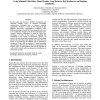Free Online Productivity Tools
i2Speak
i2Symbol
i2OCR
iTex2Img
iWeb2Print
iWeb2Shot
i2Type
iPdf2Split
iPdf2Merge
i2Bopomofo
i2Arabic
i2Style
i2Image
i2PDF
iLatex2Rtf
Sci2ools
AIM
2006
2006
Using 4D/RCS to Address AI Knowledge Integration
In this paper, we show how 4D/RCS incorporates and integrates multiple types of disparate knowledge representation techniques into a common, unifying architecture. 4D/RCS is based on the supposition that different knowledge representation techniques offer different advantages, and 4D/RCS is designed in such a way as to combine the strengths of all of these techniques into a common unifying architecture in order to exploit the advantages of each. In the context of applying the architecture to the control of autonomous vehicles, we describe the procedural and declarative types of knowledge that has been developed and applied, and value that each brings to the achieving the ultimate goal of autonomous navigation. We also look at symbolic vs. iconic knowledge representation, and show how 4D/RCS accommodates both of these types of representations and uses the strengths of each to strive towards achieving human-level intelligence in autonomous systems.
AIM 2006 | Common Unifying Architecture | Disparate Knowledge Representation | Knowledge Representation | Software Engineering |
Related Content
| Added | 10 Dec 2010 |
| Updated | 10 Dec 2010 |
| Type | Journal |
| Year | 2006 |
| Where | AIM |
| Authors | Craig Schlenoff, James S. Albus, Elena Messina, Anthony Barbera, Raj Madhavan, Stephen Balakirsky |
Comments (0)

